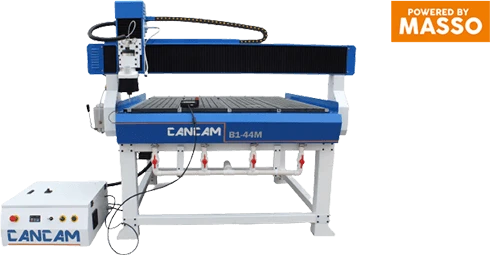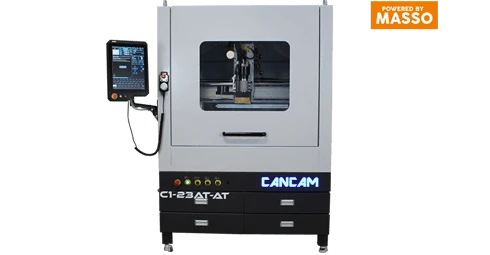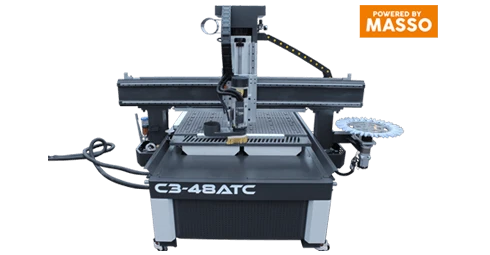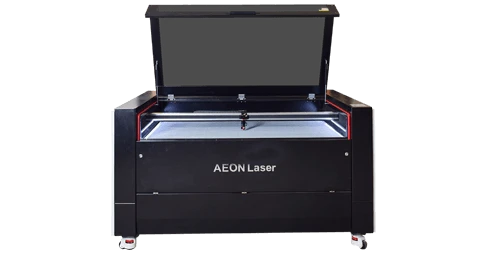Multiaxis CNC
Even experienced CNC operators can be cautious about tackling multiaxis applications. CNC can be intimidating enough without including additional axes, but there are many reasons to consider adding multiaxis capabilities to your machine. Even if you’re producing simple pieces, a multiaxis machine can save you both time and money.
What’s an Axis?
An axis is a line along which, or around which, the NC controller directs motion. Linear movements occur along a straight line. For example, a table saw cuts along a single linear axis (figure 1). Rotational movements occur around a line. For example, a lathe spins around a single rotary axis (figure 2). Traditionally, a 3-axis CNC machine has perpendicular linear axes labeled XYZ, where Z aligns with the spindle (figure 3).
Multiaxis
A multiaxis machine includes one or more additional axes than the traditional setup, giving it a greater range of movements. Four and five axes machines are typical, but more complicated setups can achieve over 100 axes. Rotary axes that rotate around XYZ are labeled ABC, and parallel linear axes along XYZ are labeled UVW. The more axes a machine has, the greater variety of movements are possible.
Indexed vs Simultaneous Machining
Multiaxis machines operate in two modes: indexed and simultaneous. Indexed machining, also known as fixed rotary or 3 + 2 machining, briefly unlocks the additional axis to rotate the workpiece, and then locks the axis again. This method maintains the rigidity of a 3-axis machine while reducing the need to reset the workpiece. Indexing is preferred for roughing work in because it is more accurate than simultaneous operation.
Simultaneous or continuous machining operates with the additional axis unlocked so movement can occur across the additional axis at the same time as the traditional three. This loose mode is less rigid than the indexed method, but allows for motion that is more complicated. Therefore, machinists use simultaneous machining for finishing cuts after they have roughed in the work using indexing.
Why Use Multiaxis Machining?
Some think of multiaxis setups as only useful for producing complicated items with difficult cuts; however, one of the most common reasons for adopting multiaxis technology is to simplify work that can be done by a 3-axis machine.
Fixturing
For instance, many 3-axis processes require rotating and refixturing the workpiece. With a multiaxis machine, a short piece of code can rotate the workpiece quickly, avoiding the extra setup and greatly improving cycle times. Avoiding extra fixturing also improves accuracy because every refixturing of the workpiece risks misalignment. Multiple fixturing can stack inaccuracies and cause significant issues. Minimal fixturing allows more aggressive cuts at higher RPM and feed rates without compromising accuracy.
Shorter Tools
Three-axis machines often use extended tools to access hard to reach sections; however, longer tools experience greater deflection, which increases vibration and makes for rougher, less precise cuts. Multiaxis machines offer better angles for cutting hard to reach sections, allowing for shorter tools with less vibration and smoother, more precise cuts.
Tilting
Positioning the tool at a tilt allows engaging with the desired cutter area, which is especially important when using rounded tools where the centre does not rotate (figure 4). Using the desired cutter area improves surface finishes, repeatability, and tool life.
Stock-Aware Tool Paths
Certain cuts on a 3-axis machine require tool paths that include movement where the tool is not cutting the workpiece (figure 5). Often, simultaneously rotating the workpiece avoids this wasted movement, significantly improving cycle times (figure 6).
New Possibilities
Although there are plenty of reasons to implement multiaxis technology to improve 3-axis processes, some cuts are only possible with a multiaxis machine. Three-axis machines cut at limited angles, so with certain cuts fixturing or the workpiece itself might cause collisions. Multiaxis machines, however, can achieve the proper angle to accomplish the desired cut. Aside from physical impossibilities, some processes are cost-prohibitive on a 3-axis machine because of the extra fixturing and excessive cycle times required. In these cases, a multiaxis machine provides new possibilities.
Multiaxis machining offers many advantages over 3-axis setups. Despite giving you more versatility, multiaxis machining can simplify your processes and actually decrease overall costs. Whether you’re looking to improve efficiencies, prolong tool life, or make cuts 3-axis machines can’t accomplish, a multiaxis setup is worth considering.








